International Toy Fair Nuremberg 2007
Internationale Spielwarenmesse Nürnberg 2007
| x |
|
|
|
|
|
|
|
|
|
|
|
|
|
|
|
|
|
|
|
|
|
|
|
|
|
|
|
|
|
|
|
|
|
 |
|
|
|
|
|
|
|
|
|
|
|
|
|
|
|
|
|
|
|
|
|
|
|
|
|
|
|
|
|
|
|
 |
|
|
|
|
|
|
|
|
|
|
|
|
|
|
|
|
|
|
|
|
|
|
|
|
|
|
|
|
|
|
|
| x |
|
|
|
|
|
|
|
|
|
|
|
|
|
|
|
|
|
|
|
|
|
|
|
|
|
|
|
|
|
|
|
|
|
| Alea/Ravensburger |
|
|
|
|
|
|
|
|
|
|
|
|
|
|
|
|
|
|
|
|
|
|
|
The final copy of ‘Notre Dame’ by Stefan Feld differs only in detail from the prototype that was presented in Essen. Some of the icons were redrawn as players kept making mistakes in interpreting them, and the effect of the council house has been minimised. Stefan Brück from Alea was very pleased with the final product, and I from my side am eagerly looking forward to play the game again! For a first impression, see the preview on ‘Notre Dame’.
Notre Dame, Stefan Feld, 2-5 players, 10 years and up, 75 minutes
|
|
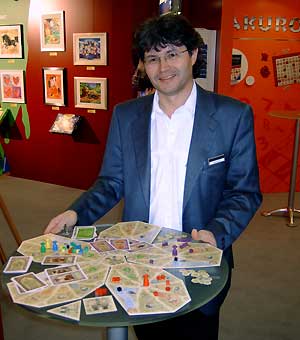 |
| x |
|
|
|
|
|
|
|
|
|
|
|
|
|
|
|
|
|
|
|
|
|
|
|
|
|
|
|
|
|
|
|
|
|
| Amigo |
|
|
|
|
|
|
|
|
|
|
|
|
|
|
|
|
|
|
|
|
|
|
|
|
|
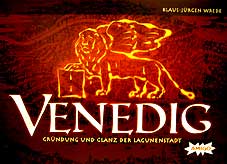
|
|
In Venedig, players drain the lagoon and slowly build on the famous town that Venice later would become. Players start with three cards that depict one of five possible buildings. In a turn, a player can play any amount of cards and build the specific building on a drained field (or more) if the number of played cards equals the requirement for that building (depicted in the upper right of a building card); otherwise he places his architect on the cards to mark it as under construction. Other players may help to construct this type of building, but only the player that has contributed the most (marked by the architect pawn) gets the full points for the construction, the other player(s) get half points rounded down.
|
| x |
|
|
|
|
|
|
|
|
|
|
|
|
|
|
|
|
|
|
|
|
|
|
|
|
|
|
|
|
|
|
|
|
|
|
The player that has his architect pawn on the building card(s) also chooses the site for the construction. The gondola moves the earned points, possibly skipping positions of other gondolas. After this, a player takes away one or two of the marsh tiles anywhere from the board, earning 1 to 3 points for it; after this he may refill his hand by either taking one card from the pool or deck, or place a card from his hand in the pool, and refill with three cards from any combination of pool and deck cards. The type of building card placed in the pool may not already be present.
|
|
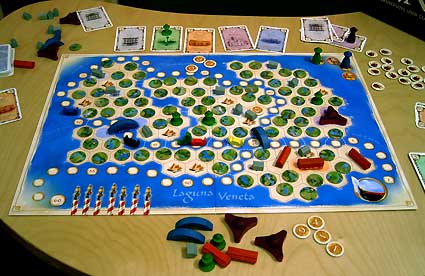 |
| x |
|
|
|
|
|
|
|
|
|
|
|
|
|
|
|
|
|
|
|
|
|
|
|
|
|
|
|
|
|
|
|
|
|
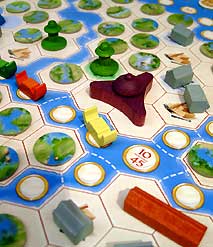 |
|
A player may not have more than 5 card on his hand. When a gondola is next to a quarter where the construction takes place, he may take a treasure tile, that can be worth from 4 to 6 points. These point can be converted in movement points at the end of the game, which is when one type of building has been completely built, or when a gondola has reached the ‘60’ field. After the final conversion of marsh and treasure points, the player has won who has got farthest with his gondola. However, a player may always convert points during his own turn, when he sees an opportunity to skip a position or two with his gondola, for example. The box has has an intriguing look, but the mapboard has very bright colours and does not quite match with the box atmosphere.
Venedig, Klaus-Jürgen Wrede, 2-5 players, 10 years and up, 60 minutes
|
| x |
|
|
|
|
|
|
|
|
|
|
|
|
|
|
|
|
|
|
|
|
|
|
|
|
|
|
|
|
|
|
|
|
|
| Californian Products |
|
|
|
|
|
|
|
|
|
|
|
|
|
|
|
|
|
|
|
|
|
|
|
Two to four players enter the pyramid of the famous Tutanchamon in search of treasures. Each turn they have three actions, one of which could be flipping the adjacent tile where their adventurer stands. Moving one tile costs another action, placing a lamp that decreases future movement an action too. The tiles in the maze can be turned by assistants, so as to hinder competing teams. Of course there are the occasional curses of mummies and winds that blaze the adventurers back to the entrance. The game comes in a very attractive tin box.
Das Gold des Pharao, prototype, Arthur Tebbe, 2-4 players, 8 years and up, 45 minutes
|
|
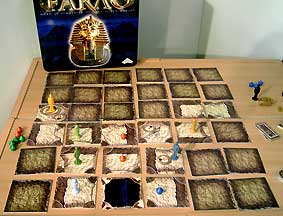 |
| x |
|
|
|
|
|
|
|
|
|
|
|
|
|
|
|
|
|
|
|
|
|
|
|
|
|
|
|
|
|
|
|
|
|
| Clementoni |
|
|
|
|
|
|
|
|
|
|
|
|
|
|
|
|
|
|
|
|
|
|
|
|
|
Four neutral trapper tokens are amidst a grid of tiles. The players move any one of them with their corresponding coloured cards -six are dealt at game start, after which a tile may be turned face up and taken and placed in a player’s row. Any number of cards may be played, but only two cards may be drawn at the end of a turn, and only one colour trapper may be moved, so no midturn switch to another trapper is possible. However, two cards of one colour may go for any other colour. A trapper may not move across the water side of a tile. The objective is to collect canoes and fill them with animals. The depicted canoes confusingly already have animals in them, but meant are the sole animal tiles that need to match the animals in the canoe.
|
|
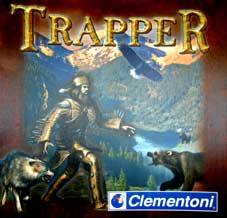 |
| x |
|
|
|
|
|
|
|
|
|
|
|
|
|
|
|
|
|
|
|
|
|
|
|
|
|
|
|
|
|
|
|
|
|
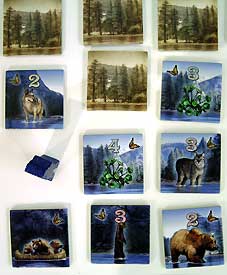 |
|
When a canoe (1, 2 or 3 animals) is full (e.i. the animals are collected), a player gets gold for it: twice the total of the number on the tiles. When the total was 16 or more, the player also may take a bonus tile that are also worth points/gold; these tiles decrease in number. The collected and scored animals are now put under the canoe. A player would want to start with a canoe, but where this tile will pop up is uncertain. Animal tiles may be placed single, but only bring points when a corresponding canoe can be found, and a trapper can reach and collect it. Multiple rows may be started. There are also shrimps and herb tiles that bring additional points; these tiles may not be placed single but must be placed in a row where already an animal tile is present. The collected and scored animals can be traded in for a bonus tile ‘most animals’ - but all collected and traded animals must be different in orde to qualify. |
| x |
|
|
|
|
|
|
|
|
|
|
|
|
|
|
|
|
|
|
|
|
|
|
|
|
|
|
|
|
|
|
|
|
|
At the end of the game there is a final scoring round, where all not yet finished canoes also score, but only single points; all single animals in rows without a canoe are minus points, and the bonus tiles are compared: the highest value brings another 12 gold, next higher 8, 5, 3, 2. There is a variant where players start out with 8 cards. The start player now either passes and takes 4 cards or announces an amount and colour of cards, then every next player must pass or name a higer number. When only one player is left, he has to play this number of coloured cards and move the corresponding trapper.
Trapper, Michael Kiesling and Wolfgang Kramer, 2-4 players, 10 years and up, 30-60 minutes |
|
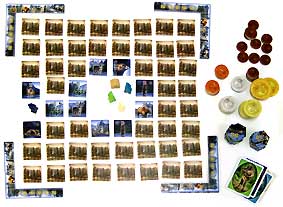 |
| x |
|
|
|
|
|
|
|
|
|
|
|
|
|
|
|
|
|
|
|
|
|
|
|
|
|
|
|
|
|
|
|
|
|
| x |
|
|
|
|
|
|
|
|
|
|
|
|
|
|
|
|
|
|
|
|
|
|
|
|
|
|
|
|
|
 |
|
|
|
|
|
|
|
|
|
|
|
|
|
|
|
|
|
|
|
|
|
|
|
|
|
|
|
|
|
|
|
 |
|
|
|
|
|
|
|
|
|
|
|
|
|
|
|
|
|
|
|
|
|
|
|
|
|
|
|
|
|
|
|
 |
|
|
|
|
|
|
|
|
|
|
|
|
|
|
|
|
|
|
|
|
|
|
|
|
|
|
|
|
|
| x |
|
|
|
|
|
|
|
|
|
|
|
|
|
|
|
|
|
|
|
|
|
|
|
|
|
|
|
|
|
|
|
|
|
 |
|
|
|
|
|
|
|
|
|
|
|
|
|
|
|
|
|
|
|
|
|
|
|
 |
|
|
|
|
|
|
|
|
|
|
|
|
|
|
|
|
|
|
|
|
|
|
|
|
|